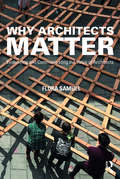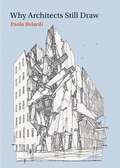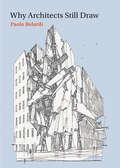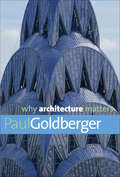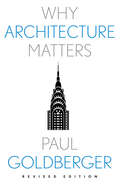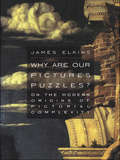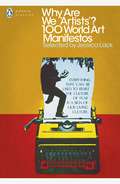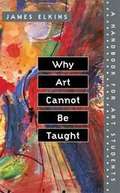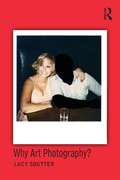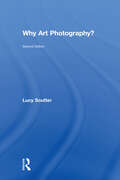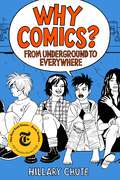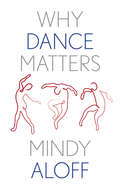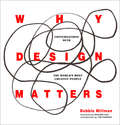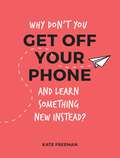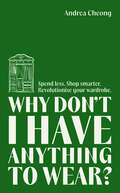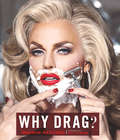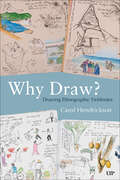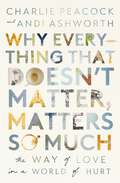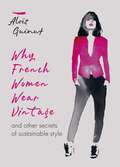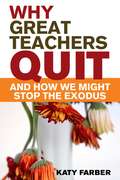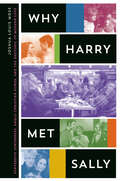- Table View
- List View
Why Architects Matter: Evidencing and Communicating the Value of Architects
by Flora SamuelWhy Architects Matter examines the key role of research- led, ethical architects in promoting wellbeing, sustainability and innovation. It argues that the profession needs to be clear about what it knows and the value of what it knows if it is to work successfully with others. Without this clarity, the marginalization of architects from the production of the built environment will continue, preventing clients, businesses and society from getting the buildings that they need. The book offers a strategy for the development of a twenty-first-century knowledge-led built environment, including tools to help evidence, develop and communicate that value to those outside the field. Knowing how to demonstrate the impact and value of their work will strengthen practitioners’ ability to pitch for work and access new funding streams. This is particularly important at a time of global economic downturn, with ever greater competition for contracts and funds driving down fees and making it imperative to prove value at every level. Why Architects Matter straddles the spheres of ‘Practice Management and Law’, ‘History and Theory’, ‘Design’, ‘Housing’, ‘Sustainability’, ‘Health’, ‘Marketing’ and ‘Advice for Clients’, bringing them into an accessible whole. The book will therefore be of interest to professional architects, architecture students and anyone with an interest in our built environment and the role of professionals within it.
Why Architects Still Draw
by Zachary Nowak Paolo BelardiWhy would an architect reach for a pencil when drawing software and AutoCAD are a click away? Use a ruler when 3D-scanners and GPS devices are close at hand? In Why Architects Still Draw, Paolo Belardi offers an elegant and ardent defense of drawing by hand as a way of thinking. Belardi is no Luddite; he doesn't urge architects to give up digital devices for watercolors and a measuring tape. Rather, he makes a case for drawing as the interface between the idea and the work itself. A drawing, Belardi argues, holds within it the entire final design. It is the paradox of the acorn: a project emerges from a drawing -- even from a sketch, rough and inchoate -- just as an oak tree emerges from an acorn. Citing examples not just from architecture but also from literature, chemistry, music, archaeology, and art, Belardi shows how drawing is not a passive recording but a moment of invention pregnant with creative possibilities. Moving from the sketch to the survey, Belardi explores the meaning of measurement in a digital era. A survey of a site should go beyond width, height, and depth; it must include two more dimensions: history and culture. Belardi shows the sterility of techniques that value metric exactitude over cultural appropriateness, arguing for an "informed drawing" that takes into consideration more than meters or feet, stone or steel. Even in the age of electronic media, Belardi writes, drawing can maintain its role as a cornerstone of architecture.
Why Architects Still Draw
by Paolo BelardiAn architect's defense of drawing as a way of thinking, even in an age of electronic media. Why would an architect reach for a pencil when drawing software and AutoCAD are a click away? Use a ruler when 3D-scanners and GPS devices are close at hand? In Why Architects Still Draw, Paolo Belardi offers an elegant and ardent defense of drawing by hand as a way of thinking. Belardi is no Luddite; he doesn't urge architects to give up digital devices for watercolors and a measuring tape. Rather, he makes a case for drawing as the interface between the idea and the work itself.A drawing, Belardi argues, holds within it the entire final design. It is the paradox of the acorn: a project emerges from a drawing—even from a sketch, rough and inchoate—just as an oak tree emerges from an acorn. Citing examples not just from architecture but also from literature, chemistry, music, archaeology, and art, Belardi shows how drawing is not a passive recording but a moment of invention pregnant with creative possibilities. Moving from the sketch to the survey, Belardi explores the meaning of measurement in a digital era. A survey of a site should go beyond width, height, and depth; it must include two more dimensions: history and culture. Belardi shows the sterility of techniques that value metric exactitude over cultural appropriateness, arguing for an “informed drawing” that takes into consideration more than meters or feet, stone or steel. Even in the age of electronic media, Belardi writes, drawing can maintain its role as a cornerstone of architecture.
Why Architecture Matters
by Paul GoldbergerWhy Architecture Mattersis not a work of architectural history or a guide to the styles or an architectural dictionary, though it contains elements of all three. The purpose ofWhy Architecture Mattersis to "come to grips with how things feel to us when we stand before them, with how architecture affects us emotionally as well as intellectually"--with its impact on our lives. "Architecture begins to matter," writes Paul Goldberger, "when it brings delight and sadness and perplexity and awe along with a roof over our heads. " He shows us how that works in examples ranging from a small Cape Cod cottage to the "vast, flowing" Prairie houses of Frank Lloyd Wright, from the Lincoln Memorial to the highly sculptural Guggenheim Bilbao and the Church of Sant'Ivo in Rome, where "simple geometries . . . create a work of architecture that embraces the deepest complexities of human imagination. " Based on decades of looking at buildings and thinking about how we experience them, the distinguished critic raises our awareness of fundamental things like proportion, scale, space, texture, materials, shapes, light, and memory. Upon completing this remarkable architectural journey, readers will enjoy a wonderfully rewarding new way of seeing and experiencing every aspect of the built world.
Why Architecture Matters (Why X Matters Series)
by Paul GoldbergerA classic work on the joy of experiencing architecture, with a new afterword reflecting on architecture’s place in the contemporary moment “Architecture begins to matter,” writes Paul Goldberger, “when it brings delight and sadness and perplexity and awe along with a roof over our heads.” In Why Architecture Matters, he shows us how that works in examples ranging from a small Cape Cod cottage to the vast, flowing Prairie houses of Frank Lloyd Wright, from the Lincoln Memorial to the Guggenheim Bilbao. He eloquently describes the Church of Sant’Ivo in Rome as a work that “embraces the deepest complexities of human imagination.” In his afterword to this new edition, Goldberger addresses the current climate in architectural history and takes a more nuanced look at projects such as Thomas Jefferson’s academical village at the University of Virginia and figures including Philip Johnson, whose controversial status has been the topic of much recent discourse. He argues that the emotional impact of great architecture remains vital, even as he welcomes the shift in the field to an increased emphasis on social justice and sustainability.
Why Are Our Pictures Puzzles?: On the Modern Origins of Pictorial Complexity
by James ElkinsWith bracing clarity, James Elkins explores why images are taken to be more intricate and hard to describe in the twentieth century than they had been in any previous century. Why Are Our Pictures Puzzles? uses three models to understand the kinds of complex meaning that pictures are thought to possess: the affinity between the meanings of paintings and jigsaw-puzzles; the contemporary interest in ambiguity and 'levels of meaning'; and the penchant many have to interpret pictures by finding images hidden within them. Elkins explores a wide variety of examples, from the figures hidden in Renaissance paintings to Salvador Dali's paranoiac meditations on Millet's Angelus, from Persian miniature paintings to jigsaw-puzzles. He also examines some of the most vexed works in history, including Watteau's "meaningless" paintings, Michelangelo's Sistine Ceiling, and Leonardo's Last Supper.
Why Are We 'Artists'?: 100 World Art Manifestos (Penguin Modern Classics)
by Jessica Lack'Art is not a luxury. Art is a basic social need to which everyone has a right'.This extraordinary collection of 100 artists' manifestos from across the globe over the last 100 years brings together political activists, anti-colonialists, surrealists, socialists, nihilists and a host of other voices. From the Négritude movement in Europe, Africa and Martinique to Japan's Bikyoto, from Iraqi modernism to Australian cyberfeminism, they are by turns personal, political, utopian, angry, sublime and revolutionary. Some have not been published in English before; some were written in climates of censorship and brutality; some contain visions of a future still on the horizon. What unites them is the belief that art can change the world.
Why Art Cannot Be Taught: A Handbook for Art Students
by James ElkinsIn this smart survival guide for students and teachers - the only book of its kind - James Elkins examines the curious endeavor to teach the unteachable that is generally known as college-level art instruction. This singular project is organized around a series of conflicting claims about art: Art can be taught, but nobody knows quite how. Art can be taught, but it seems as if it can't be since so few students become outstanding artists. Art cannot be taught, but it can be fostered or helped along. Art cannot be taught or even nourished, but it is possible to teach right up to the beginnings of art so that students are ready to make art the moment they graduate. Great art cannot be taught, but more run-of-the-mill art can be. Elkins traces the development (or invention) of the modern art school and considers how issues such as the question of core curriculum and the intellectual isolation of art schools affect the teaching and learning of art. art as a whole and dissects real-life critiques, highlighting presuppositions and dynamics that make them confusing and suggesting ways to make them more helpful. Elkins's no-nonsense approach clears away the assumptions about art instruction that are not borne out by classroom practice. For example, he notes that despite much talk about instilling visual acuity and teaching technique, in practice neither teachers nor students behave as if those were their principal goals. He addresses the absurdity of pretending that sexual issues are absent from life-drawing classes and questions the practice of holding up great masters and masterpieces as models for students capable of producing only mediocre art. He also discusses types of art - including art that takes time to complete and art that isn't serious - that cannot be learned in studio art classes. Why Art Cannot Be Taught is a response to Elkins's observation that we know very little about what we do in the art classroom. involved in it, while opening an intriguing window for those outside the discipline.
Why Art Photography?
by Lucy SoutterContemporary art photography is paradoxical. Anyone can look at it and form an opinion about what they see, yet it represents critical positions that only a small minority of well-informed viewers can usually access. Why Art Photography? provides a lively, accessible introduction to the ideas behind today’s striking photographic images. Exploring key issues such as ambiguity, objectivity, staging, authenticity, the digital and photography’s expanded field, the chapters offer fresh perspectives on existing debates. While the main focus is on the present, the book traces concepts and visual styles to their origins, drawing on carefully selected examples from recognized international photographers. Images, theories and histories are described in a clear, concise manner and key terms are defined along the way. This book is ideal for anyone wanting to deepen their understanding of photography as an art form.
Why Art Photography?
by Lucy SoutterThe second edition of Why Art Photography? is an updated, expanded introduction to the ideas behind today’s striking photographic images. Lively, accessible discussions of key issues such as ambiguity, objectivity, fiction, authenticity, and photography’s expanding field are supplemented with new material around timely topics such as globalization, selfie culture, and photographers’ use of advanced digital technologies, including CGI and virtual reality. The new edition includes: an expanded introduction extended chapters featuring emerging trends a larger selection of images, including new color images an improved and expanded bibliography. This new edition is essential for students looking to enrich their understanding of photography as a complex and multi-faceted art form.
Why Buildings Stand Up: The Strength of Architecture
by Mario SalvadoriHere is a clear and enthusiastic introduction to building methods from ancient time to the present day, illustrated throughout with line drawings. In addition, Mr. Salvadori discusses recent advances in science and technology that have had important effects on the planning and construction of buildings.
Why Christianity Must Change or Die: A Bishop Speaks to Believers In Exile
by John Shelby SpongFrom back cover: [Spong presents his] controversial stands on the Bible, Jesus, theism, and ... [He calls] for a Christianity based on critical thought rather than blind faith, on love rather than judgment, and that focuses on life more than religion.
Why Comics?: From Underground to Everywhere
by Hillary ChuteFilled with beautiful full-color art, dynamic storytelling, and insightful analysis, Hillary Chute’s Why Comics? reveals what makes one of the most critically acclaimed and popular art forms unique and so appealing, and how it got that way. <p><p> Over the past century, fans have elevated comics from the back pages of newspapers into one of our most celebrated forms of culture, from Fun Home, the Tony Award–winning musical based on Alison Bechdel’s groundbreaking graphic memoir, to the dozens of superhero films that are annual blockbusters worldwide. What is the essence of comics’ appeal? What does this art form do that others can’t? <p> Whether you’ve read every comic you can get your hands on or you’re just starting your journey, Why Comics? has something for you. Author Hillary Chute chronicles comics culture, explaining underground comics (also known as “comix”) and graphic novels, analyzing their evolution, and offering fascinating portraits of the creative men and women behind them. Chute reveals why these works—a blend of concise words and striking visuals—are an extraordinarily powerful form of expression that stimulates us intellectually and emotionally. <p> Focusing on ten major themes—disaster, superheroes, sex, the suburbs, cities, punk, illness and disability, girls, war, and queerness—Chute explains how comics gets its messages across more effectively than any other form. “Why Disaster?” explores how comics are uniquely suited to convey the scale and disorientation of calamity, from Art Spiegelman’s representation of the Holocaust and 9/11 to Keiji Nakazawa’s focus on Hiroshima. “Why the Suburbs?” examines how the work of Chris Ware and Charles Burns illustrates the quiet joys and struggles of suburban existence; and “Why Punk?” delves into how comics inspire and reflect the punk movement’s DIY aesthetics—giving birth to a democratic medium increasingly embraced by some of today’s most significant artists. <p> Featuring full-color reproductions of more than one hundred essential pages and panels, including some famous but never-before-reprinted images from comics legends, Why Comics? is an indispensable guide that offers a deep understanding of this influential art form and its masters.
Why Dance Matters (Why X Matters Series)
by Mindy AloffA passionate and moving tribute to the captivating power of dance, not just as an art form but as a language that transcends barriers &“A veritable master class.&”—Anne Doventry, Booklist Mindy Aloff, a journalist, an essayist, and a dance critic, analyzes dance as the ultimate expression of human energy and feeling. From her personal anecdotes, her engaging collection of stories about dance from around the world, or her description of the captivating photograph by Helen Levitt of two children dancing, which she sees as one embodiment of the mystery and joy that dancing can evoke, Aloff&’s exploration of the aesthetic, social, and spiritual impacts of dance will prove spellbinding. Aloff takes us on a journey through various forms of dance—rituals, religious observances, storytelling, musical interpretations—to show why dance matters to human beings. Interlaced with personal experiences, this book builds on analysis to reveal the intimate relationship we have with dance—personal, spiritual, soul-searching, medicinal, and entertaining. The ideas speak to both specialist and general readers.
Why Design Matters: Conversations with the World's Most Creative People
by Debbie MillmanForeword by Roxane Gay“Debbie Millman brings her Design Matters podcast, ‘about how the most creative people in the world create their lives,’ to the page with this excellent interview anthology. Sharpened by Millman’s penetrating commentary, the candid musings teem with insight and empathy. This sparkling collection is one to be savored slowly.”—Publisher’s WeeklyThe author, educator, brand consultant, and host of the widely successful and award-winning podcast Design Matters showcases dozens of her most exciting interviews, bringing together insights and reflections from today’s leading creative minds from across diverse fields.“Debbie Millman has become a singular voice in the world of intimate, enlightening conversations. She has demonstrated time, and again, why design matters.”—Roxane Gay, from the forewordOver the course of her popular podcast’s fifteen-year reign, Debbie Millman has interviewed more than 400 creative minds. In those conversations, she has not only explored what it means to design a creative life, but has, as Millman’s wife, Roxane Gay, assesses in her foreword, “created a gloriously interesting and ongoing conversation about what it means to live well, overcome trauma, face rejection, learn to love and be loved, and thrive both personally and professional.”In this illustrated, curated anthology, Millman includes approximately 80 of her best interviews with visionaries from across diverse fields. Grouped by category—Legends, Truth Tellers, Culture Makers, Trendsetters, and Visionaries—these eye-opening, entertaining, and enlightening conversations—offer insights into new ways of being and living. Accompanying each entry is a brief biography, a portrait photographed by Millman, and a pull quote written in Millman’s artistic hand. Why Design Matters features 100 images and includes interviews with:Marina Abramovic, Cey Adams, Elizabeth Alexander, Laurie Anderson, Lynda Barry, Allison Bechdel, Michael Bierut, Brené Brown, Alain de Botton, Eve Ensler, Shepard Fairey, Tim Ferriss, Louise Fili, Kenny Fries, Anand Girhidardas, Cindy Gallop, Malcolm Gladwell, Milton Glaser, Ira Glass, Seth Godin, Thelma Golden, Gabrielle Hamilton, Steven Heller, Jessica Hische, Michael R. Jackson, Oliver Jeffers, Saeed Jones, Thomas Kail, Maira Kalman, Chip Kidd, Anne Lamott, Elle Luna, Carmen Maria Machado, Thomas Page McBee, Erin McKeown, Chanel Miller, Mike Mills, Marilyn Minter, Isaac Mizrahi, Nico Muhly, Eileen Myles, Emily Oberman, Amanda Palmer, Priya Parker, Esther Perel, Maria Popova, Edel Rodriguez, Paula Scher, Amy Sherald, Simon Sinek, Pete Souza, Aminatou Sow, Brandon Stanton, Cheryl Strayed, Amber Tamblyn, Christina Tosi, Tea Uglow, Chris Ware, and Albert Watson.
Why Don't You Get Off Your Phone and Learn Something New Instead?: Fun, Quirky and Interesting Alternatives to Browsing Your Phone
by Kate FreemanWhether you want to fill five minutes or spend an entire afternoon, this handy guide is bursting with trivia, facts and suggestions of things to do instead of being on your phone, from the useful, to the fun, to the downright bizarre. Become the most interesting person you know: put down your phone, pick up this book and learn something new!
Why Don’t I Have Anything to Wear?
by Andrea CheongSustainable Clothing On a BudgetCloset filled with clothes, but nothing to wear? You’re not alone.Escape from shopping addiction. You don’t need new expensive clothes to improve your life. Using her 5-step programme, fashion blogger, stylist, and viral Tik-Tok star Andrea Cheong teaches you how to repair your relationship with clothing through emotional insight and shopping tips and tricks. In a world of fast fashion, buying less and saving more has never been easier.Sustainable living, on a budget. Want to save money and the planet? Learn to buy what you really want─look past marketing and retail mind games into the quality of your clothes. With a breakdown of different fashion processes and her iconic Mindful Monday (5-step) Method, Andrea shows you how to find your style, while not adding to consumerism and global waste.Inside, you’ll find:Fun interactive quizzes, checklists, and decision trees to save money, shop smarter, and create a wardrobe that works for youInsight into affordable sustainable clothing and ethical clothing brands, including an overview of slow fashion and the secondhand marketLearn how to analyze different types of fabric and materials so you can only buy clothing essentialsIf you liked The Life-Changing Magic of Tidying Up, The Ultimate Book of Outfit Formulas, or Life Styling, you’ll love Why Don’t I Have Anything to Wear?
Why Drag?
by Magnus HastingsFor over a decade, Magnus Hastings has been photographing the world's greatest drag superstars and asking each of them a simple question: Why drag? The result is this mesmerizing volume in which the queens strut their stuff and reflect on their shared passion through a mixture of quips and philosophizing. Subjects include icons of reality TV and underground drag royalty, and photographs range from the divine to the trashy. Featuring the likes of Bianca Del Rio and Courtney Act, this collection is a beautiful celebration of drag as an art form and an exhilarating exploration of what drag means to its greatest artists.
Why Draw?: Drawing Ethnographic Fieldnotes
by Carol HendricksonIn Why Draw?, Carol Hendrickson explores the potential of drawing within the context of ethnographic fieldwork. The book aims to inspire readers to immerse themselves in the generative process of thinking while seeing while drawing. To foster visual thinking and encourage experimentation, Hendrickson discusses a range of case studies that show the possibilities of drawing in the field and thinking through the resulting drawings. Richly illustrated, the book focuses on current theoretical and methodological considerations in the social sciences, including semiotic issues of representation and indexicality, embodiment and the senses, affect, collaboration, and temporality. Chapters are supplemented with exercises, practical advice, and short interludes that provide inspiration. At its heart, Why Draw? asks readers to create visual notes in new and different ways; contemplate a range of contemporary issues through the act of drawing; and explore the potential of drawing to act as a bridge between fieldwork and finished works destined for public presentation.
Why Everything That Doesn't Matter, Matters So Much: The Way of Love in a World of Hurt
by Charlie Peacock Andi AshworthA hopeful and practical model for what it means to be a Christian and a culture-maker in a world of hurt and wondrous possibility, from multi–Grammy winner Charlie Peacock and his wife and author, Andi Ashworth.Do you feel powerless and overwhelmed by the pain and suffering all around you? Have you ever asked, What can I do to mend the world, my family, or my own life? And if I could, why bother? Does my own small part even matter? If so, here comes hope from two guides who are further down the road. Charlie and Andi have written a collection of letters to Christians and spiritual seekers who think deeply and care acutely about the state of the world and their personal spheres of influence.In Why Everything That Doesn't Matter, Matters So Much, beloved and trusted mentors, Charlie and Andi offer you:Thought-provoking explorations into the many facets of Christian culture care and making, from the kitchen to Carnegie Hall.Practical guidance for how to care for and improve the quality of human life, locally and globally, no matter your vocation.A theology of imagination and creativity that provides a framework for all of life.A model for expressing love in marriage, friendship, citizenship, and every kind of work—even in the midst of cynicism, fear, exhaustion, and oppression. It might be said of Christians that our lives are either moving in the direction of the redemption Jesus has on offer, or away from it. Each of these letters is a gentle nudge in the direction of God's powerfully ordinary purpose for each of us, no matter what the future holds, to participate fully in the beautiful, redemptive work of Christ.
Why French Women Wear Vintage: and other secrets of sustainable style
by Aloïs Guinut"The sustainable fashion revolution has begun, and we must all be part of it." - Aloïs GuinutStylish women everywhere are realizing the environmental damage of fast fashion and looking for new ways to dress that don't involve cramming their wardrobe with clothes that may never get worn. As Paris-based style-coach Aloïs Guinut explores in this invaluable book, French women have a lot to teach us about how to cherish the planet without sacrificing your style:- Know what works for you.- Buy less and buy better.- Mix vintage items with a few wisely chosen modern pieces.- Optimize your closet.- Look after what you have and make it last.- Seek out quality fabrics that don't poison the environment.
Why French Women Wear Vintage: and other secrets of sustainable style
by Aloïs Guinut"The sustainable fashion revolution has begun, and we must all be part of it." - Aloïs GuinutStylish women everywhere are realizing the environmental damage of fast fashion and looking for new ways to dress that don't involve cramming their wardrobe with clothes that may never get worn. As Paris-based style-coach Aloïs Guinut explores in this invaluable book, French women have a lot to teach us about how to cherish the planet without sacrificing your style:- Know what works for you.- Buy less and buy better.- Mix vintage items with a few wisely chosen modern pieces.- Optimize your closet.- Look after what you have and make it last.- Seek out quality fabrics that don't poison the environment.
Why Great Teachers Quit and How We Might Stop the Exodus: And How We Might Stop The Exodus
by Katy FarberLearn why today’s best teachers are leaving-from the teachers themselves.Low pay, increased responsibilities, and high-stakes standardized testing-these are just some of the reasons why more talented teachers are leaving the profession than ever before. Drawing on in-depth interviews with teachers all over the country, Katy Farber presents an in-the-trenches view of the classroom exodus and uncovers ways that schools can turn the tide.Farber's findings, which have been featured on Education Talk Radio, Vermont Public Radio, and in the Huffington Post, paint a sometimes shocking picture of life in today's schools, taking a frank look at Challenges to teacher endurance, including tight budgets, difficult parents, standardized testing, unsafe schools, inadequate pay, and lack of respect Strategies veteran teachers use to make sure the joys of teaching outweigh the frustrations Success stories from individual schools and districts that have found solutions to these challenges Recommendations for creating a school environment that fosters teacher retentionFeaturing clear analysis and concrete suggestions for administrators and policy makers, Why Great Teachers Quit takes you to the front lines of the fight to keep great teachers where they belong: in the classroom.
Why Harry Met Sally: Subversive Jewishness, Anglo-Christian Power, and the Rhetoric of Modern Love
by Joshua Louis MossFrom immigrant ghetto love stories such as The Cohens and the Kellys (1926), through romantic comedies including Meet the Parents (2000) and Knocked Up (2007), to television series such as Transparent (2014–), Jewish-Christian couplings have been a staple of popular culture for over a century. In these pairings, Joshua Louis Moss argues, the unruly screen Jew is the privileged representative of progressivism, secular modernism, and the cosmopolitan sensibilities of the mass-media age. But his/her unruliness is nearly always contained through romantic union with the Anglo-Christian partner. This Jewish-Christian meta-narrative has recurred time and again as one of the most powerful and enduring, although unrecognized, mass-culture fantasies. Using the innovative framework of coupling theory, Why Harry Met Sally surveys three major waves of Jewish-Christian couplings in popular American literature, theater, film, and television. Moss explores how first-wave European and American creators in the early twentieth century used such couplings as an extension of modernist sensibilities and the American “melting pot.” He then looks at how New Hollywood of the late 1960s revived these couplings as a sexually provocative response to the political conservatism and representational absences of postwar America. Finally, Moss identifies the third wave as emerging in television sitcoms, Broadway musicals, and “gross-out” film comedies to grapple with the impact of American economic globalism since the 1990s. He demonstrates that, whether perceived as a threat or a triumph, Jewish-Christian couplings provide a visceral, easily graspable, template for understanding the rapid transformations of an increasingly globalized world.
Why Harry Met Sally: Subversive Jewishness, Anglo-Christian Power, and the Rhetoric of Modern Love
by Joshua Louis MossFrom immigrant ghetto love stories such as The Cohens and the Kellys (1926), through romantic comedies including Meet the Parents (2000) and Knocked Up (2007), to television series such as Transparent (2014–), Jewish-Christian couplings have been a staple of popular culture for over a century. In these pairings, Joshua Louis Moss argues, the unruly screen Jew is the privileged representative of progressivism, secular modernism, and the cosmopolitan sensibilities of the mass-media age. But his/her unruliness is nearly always contained through romantic union with the Anglo-Christian partner. This Jewish-Christian meta-narrative has recurred time and again as one of the most powerful and enduring, although unrecognized, mass-culture fantasies. Using the innovative framework of coupling theory, Why Harry Met Sally surveys three major waves of Jewish-Christian couplings in popular American literature, theater, film, and television. Moss explores how first-wave European and American creators in the early twentieth century used such couplings as an extension of modernist sensibilities and the American “melting pot.” He then looks at how New Hollywood of the late 1960s revived these couplings as a sexually provocative response to the political conservatism and representational absences of postwar America. Finally, Moss identifies the third wave as emerging in television sitcoms, Broadway musicals, and “gross-out” film comedies to grapple with the impact of American economic globalism since the 1990s. He demonstrates that, whether perceived as a threat or a triumph, Jewish-Christian couplings provide a visceral, easily graspable, template for understanding the rapid transformations of an increasingly globalized world.
